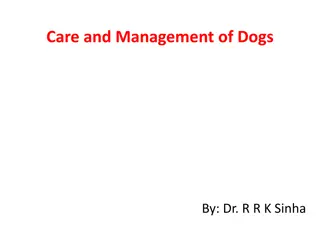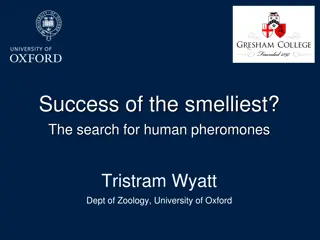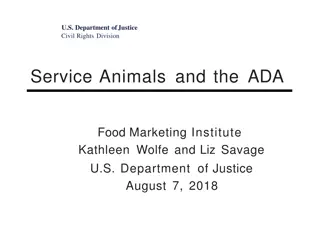Understanding Pheromones and Interomones in Anxious Dogs
Pheromones and interomones are species-specific chemical signals that can modulate heart rate and behavior in anxious dogs. This study investigates the efficacy of pheromones/interomones in influencing adult anxious dogs and explores their impact on heart rate and behavior. By examining how dogs receive and respond to these chemical cues, valuable insights are gained into their potential use for calming anxious dogs.
Download Presentation

Please find below an Image/Link to download the presentation.
The content on the website is provided AS IS for your information and personal use only. It may not be sold, licensed, or shared on other websites without obtaining consent from the author. Download presentation by click this link. If you encounter any issues during the download, it is possible that the publisher has removed the file from their server.
E N D
Presentation Transcript
Pheromones and interomones that change heart rate and behavior of anxious dogs W. Garrett Thompson and J. J. McGlone Dept Animal and Food Sciences, Laboratory of Animal Behavior, Physiology and Welfare, Texas Tech University July 18, 2012
Introduction What are pheromones? Pheromones are species-specific odors used in communication between a sender and a receiver (Karlson and Luscher 1959). Certain pheromones (also called Kairomones) have been shown to operate across species and can either benefit or harm the sender or receiver. The term interomone refer to a chemical that operates in a given species but will have very different effects on the receiver animal of a different species.
Introduction How does a dog receive a pheromone? Pheromones are taken into the dog by way of the vomeronasal organ and the main olfactory epithelium. Liquids may not activate sensory neurons in the MOE and the olfactory bulb they must be aerosols.
Objective The objective of this study assess efficacy of pheromones/interomones to modulate heart rate and behavior in adult anxious dogs.
Materials and Methods The dogs (8.1 0.18 kg; estimated 5-12 yr intact males) were obtained from a local research facility. Each dog was housed in a separately ventilated room with a minimum of 12 m of floor space. Heart rate (HR) and surface temperature were measured using telemetry system (Data Science International, St. Paul, MN). Behavioral scan samples were used with a recording interval of 5 min over 24 h. At the end of the 24 h period for a given treatment, each dog was startled with a 110 db air horn approximately 12 cm from the dog s head while behavior and heart rate were recorded. Each dog received each treatment in a Latin square design with repeated measures over time. This model allowed evaluation of effects of treatment, dog, treatment by dog, time, treatment by time and dog by time.
Materials and Methods Treatments Groups: administered in collar form. Sergeant s (SERG) pheromone collar, 2-methylbut-2-enal-Rabbit Pheromone (RP) collar SERG+RP combined collar Placebo/Control Heart rate and behavior were evaluated in two phases: 1. A baseline or 24h period before the startle was administered. 2. A startle period after the initial 24h period in which the heart rate and behavior where measured for 2-3 hours.
Results: Heart Rate Heart rate was changed by treatments: Baseline 24h HR did not differ among treatments Average = 110.1 13.3 bpm) When Startled, Rabbit Pheromone lowered (P < 0.01) HR compared to placebo RP = 124.5 7.2 bpm vs. Placebo = 157.8 7.2 bpm. The treatment by dog interaction (P < 0.01) indicated that certain dogs were more responsive than others.
Heart rate: Dog*Treatment Dogs 1 and 3 had lower HR with RP
Behavior Dogs with Rabbit pheromone collars reduced the time spent pacing (P =0.05) and spent more time lying down (P = 0.04) compared to placebo-treated dogs (explains lower HR). Over time RP dogs spent more time lying down over the 24h period (P = 0.004). 2/4 dogs spent less time pacing when treated with rabbit pheromone compared to placebo, while only one dog showed a significant decrease when treated with the Rp+Serg collar.
Behavior Increased lying down with RP, on average and over time (except mid day) Rabbit Pheromone vs Placebo Time spent lying down (P = 0.03, SEM = 8.7) (P = 0.04, SEM = 8.76) 120 * 100 80 Percent % 60 40 Placebo 20 RP 0 0 5 10 15 20 25 Hour
Startle Behavior Time spent pacing, sitting, and lying were all effected during the startle period. Rabbit Pheromone was the only pheromone that had an effect in behaviors (Pacing P = 0.04, sitting P = 0.002, and sitting over time P = 0.03) Serg+Rp had the greatest increase in initial sitting behavior after startle.
Startle Behavior RP vs Control Percent Pacing After Startle (P = 0.04, SEM = 1.68) Percent Sitting After Startle (P = <0.001, SEM = 1.01) 10 25 * d 8 20 15 6 Percent % Percent % bc 10 4 ab a 5 2 0 0 Placebo SERG RP RP+SERG Placebo Rp Treatment Treatment
Startle Behavior Trt*Time Interactions After Startle Percent Time Spent Sitting (P = 0.03, SEM = 1.80) 35 * 30 * 25 Percent % 20 * 15 + 10 + 5 0 24 25 26 Hour Placebo SERG RP RP+SERG
Conclusions Behavior and physiology (HR) can be used to assess dog responses to pheromones and interomones. The RP was most effective at lowering HR and changing the behavior of anxious dogs. The significant dog*treatment interaction indicated that anxious dogs responded differentially to the RP

























